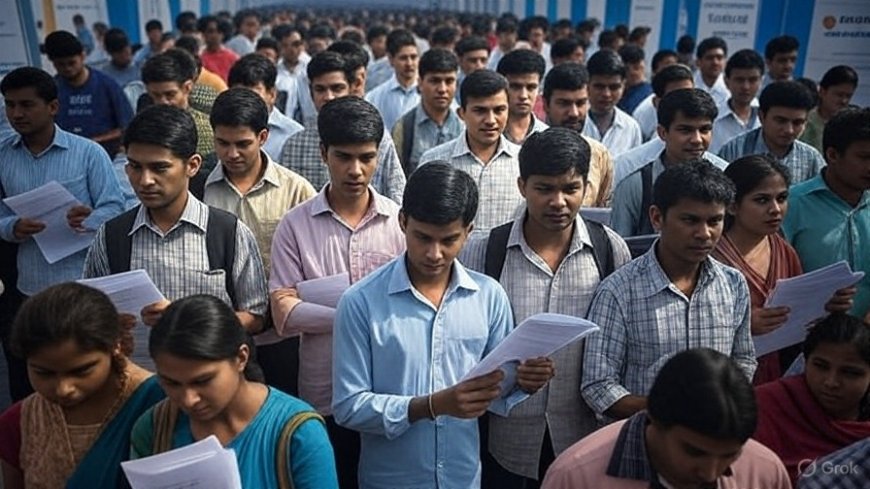Hidden Unemployment: Economists Warn India’s Real Jobless Rate Could Be Nearly Double Official 5.6%
Over 70% of economists surveyed by Reuters say India’s official unemployment rate of 5.6% underestimates true joblessness, with real figures likely double. Experts cite outdated definitions, underemployment and wage stagnation.

A recent Reuters poll has raised serious doubts about India’s official unemployment rate of 5.6%, reported for June 2025 by the Periodic Labour Force Survey (PLFS). According to the poll, over 70% of independent economists believe that the real jobless rate is nearly double the official figure, suggesting the true rate lies closer to 10% or more—possibly rising as high as 35% in some expert estimates Reuters+10Reuters+10The Economic Times+10.
Why the Discretion in Official Data?
The PLFS considers individuals who have worked even for one hour a week as employed—a threshold that critics say masks significant underemployment and job insecurity Telegraph India+5Reuters+5The Economic Times+5. Experts like Pranab Bardhan, Professor Emeritus at UC Berkeley, argue that this narrow definition amounts to "throwing dust in your eyes" when India's labor market lacks adequate meaningful work DhanamOnline English+5Reuters+5Business Standard+5.
Furthermore, by counting subsistence-based household labor as employment, the official methodology deviates from international norms, rendering India’s unemployment figures incomparable to those of other countries Yahoo Finance+13DhanamOnline English+13The Economic Times+13.
The Economist Verdict: A Spectrum of Concern
In the Reuters survey conducted last month, 37 out of 50 economists expressed skepticism about the official data Facebook+10Reuters+10The Economic Times+10. Among those surveyed, 17 experts provided alternative estimates, with a median around 10%, and some suggesting a rate as high as 35% Telegraph India+5Reuters+5Business Standard+5.
Former RBI Governor Duvvuri Subbarao called for a renewed focus on manufacturing-led job creation, noting that sectors like IT and finance—while driving GDP—do little for large-scale employment Telegraph India+5Reuters+5DhanamOnline English+5. Others, such as Jayati Ghosh of the University of Massachusetts Amherst, highlighted stagnant real wages, with half of workers earning less than a decade ago—offering evidence of underutilized labor The Economic Times+4Reuters+4DhanamOnline English+4.
The Youth and Gender Dimensions
According to PLFS data, youth unemployment remains higher than the national average, while female labor-force participation has stagnated Reuters+1The Economic Times+1. A separate Reuters poll concerning women’s employment projected that it may take 20–30 years for India to reach G20 female workforce levels X (formerly Twitter)+5Reuters+5The Economic Times+5.
Academics and policy experts argue that low-quality, survival-based self-employment among women inflates participation statistics without delivering welfare or economic empowerment Reuters.
Broader Implications for India’s Growth Story
India may boast a 7.4% GDP growth rate for the January–March quarter, branding itself “the world’s fastest-growing major economy” DhanamOnline English+5Reuters+5Business Standard+5. However, critics assert that the benefits are unequally shared, with the bulk of growth concentrated in capital-intensive sectors like IT and services—which generate limited jobs relative to output.
This phenomenon is often described as “jobless growth”, where GDP rises but job creation lags, depriving millions—especially young graduates—of stable employment options Wikipedia+9lemonde.fr+9The Economic Times+9.
Policy Gaps in Current Employment Data Systems
India’s reliance on the PLFS and discontinuation of the older five-year NSSO surveys has led to data gaps Wikipedia+1The Economic Times+1. Economists express concerns that infrequent data collection, along with definitions that count minimal activity as employment, result in distorted labor market assessments.
Former IMF director Surjit Bhalla defends the PLFS’s methodology but concedes that the public’s distrust is rooted in visible inequality—where high growth coexists with jobless stagnation ReutersThe Economic Times+2DhanamOnline English+2The Economic Times+2.
Solutions on the Table: From Manufacturing to Skills
Experts suggest several measures:
-
Expand manufacturing policy to encourage labor-intensive industries timesofindia.indiatimes.comDhanamOnline English+3Reuters+3The Economic Times+3.
-
Revamp employment surveys to capture underemployment and non-standard work.
-
Strengthen vocational training and education to reduce skills mismatch in a young workforce.
-
Promote gender-inclusive employment through robust childcare infrastructure and safer workplaces—focusing on real job quality rather than superficial participation WikipediaReuters.
The Road Ahead for Government and Stakeholders
The Ministry of Statistics and Programme Implementation (MoSPI) has defended the PLFS, noting its sample-based, computer-assisted methodology and global usage by international bodies Telegraph India+5Reuters+5Business Standard+5.
Still, opposition politicians and the INDIA alliance have highlighted unemployment and deteriorating youth sentiments as key electoral issues. With India’s demographic dividend at risk, India’s policymakers may face mounting pressure to address structural unemployment issues Wikipedialemonde.fr.
Final Word: Rethinking Growth Beyond GDP
India’s current economic narrative of high growth conceals critical shortcomings in employment and inclusion. With a majority of economists suggesting the actual unemployment rate could be nearly double the official figure, the need for comprehensive labor reforms and transparent data systems is more urgent than ever.
Austerity masked by prosperity no longer suffices. As youth unemployment swells and female labor engagement remains limited, India's challenge is clear: ensure that rising GDP translates into real jobs, fair wages, and widely shared progress.




















































